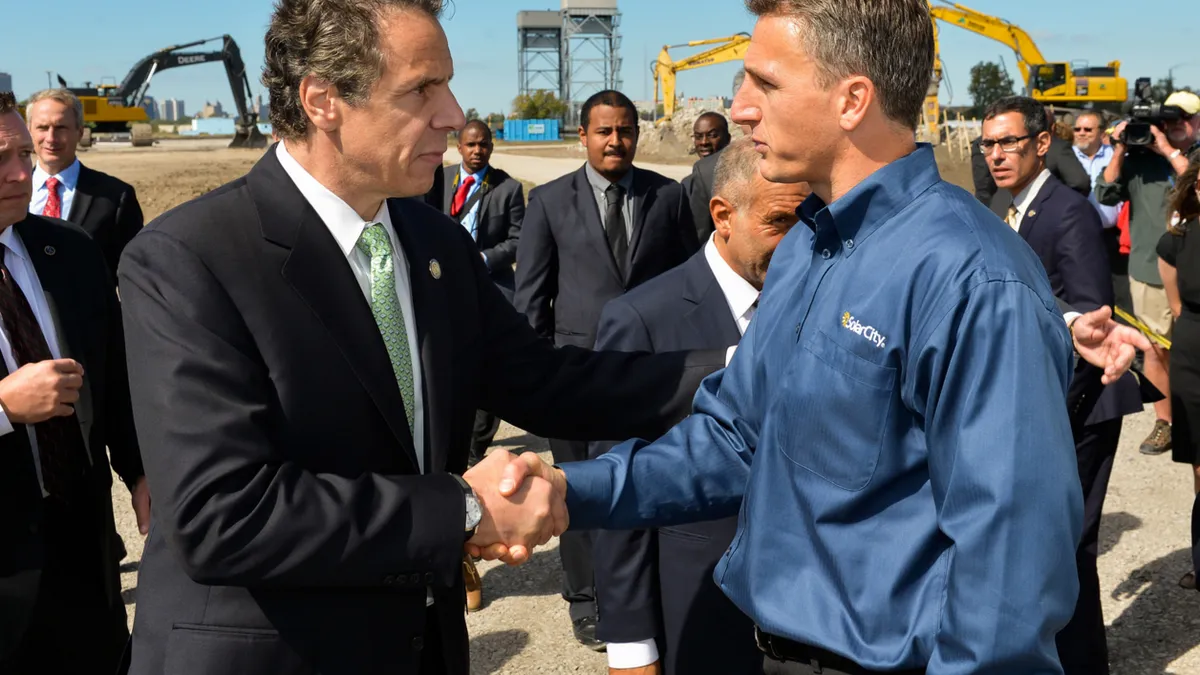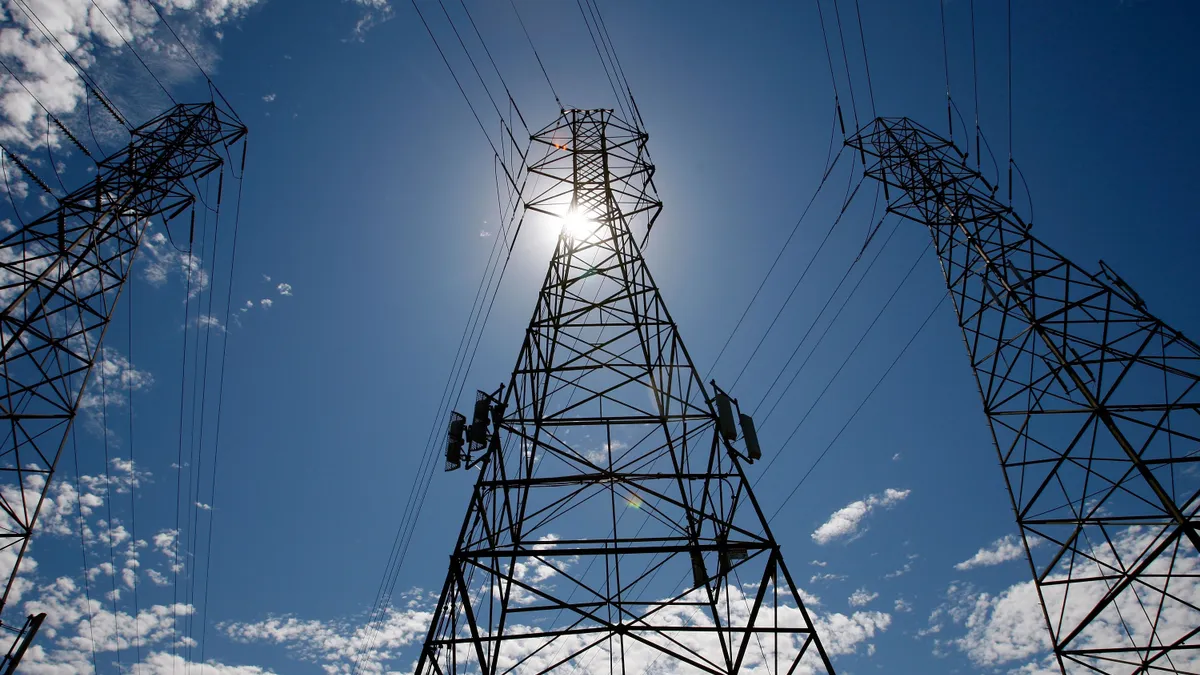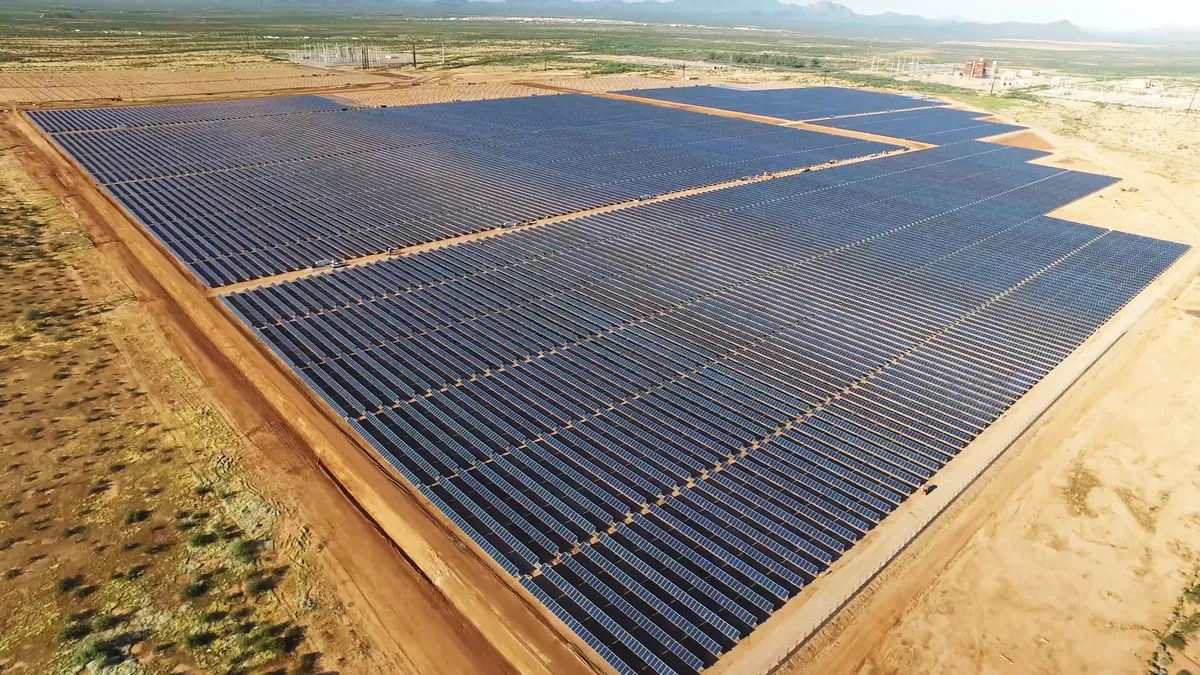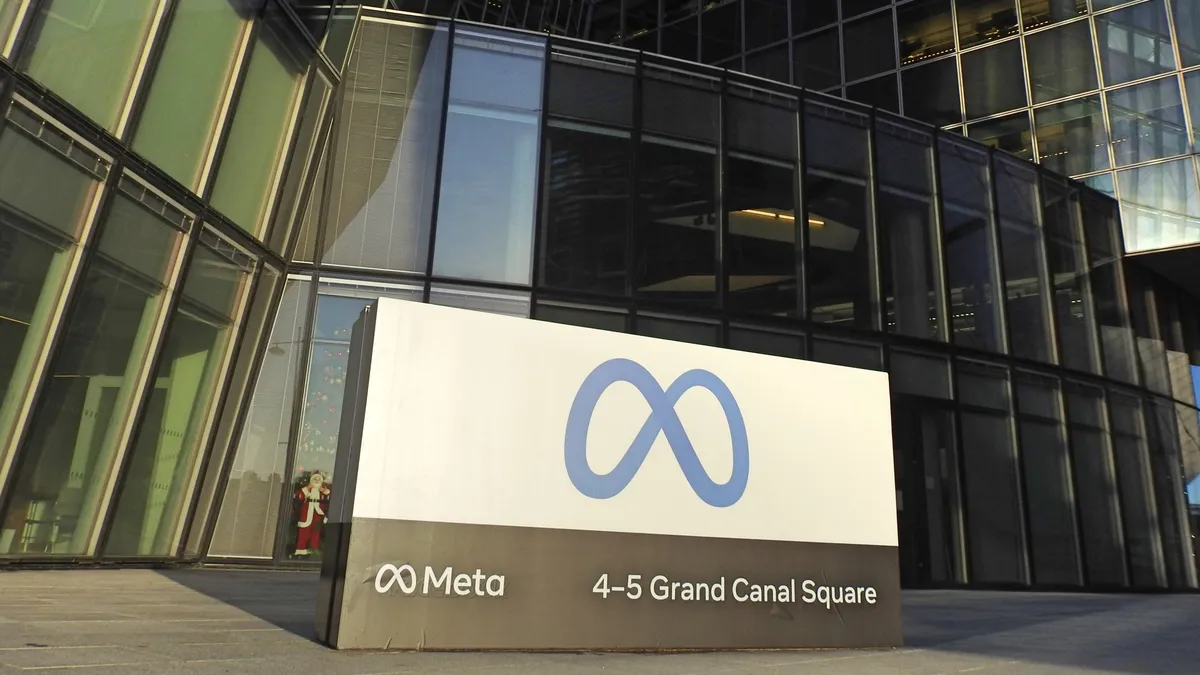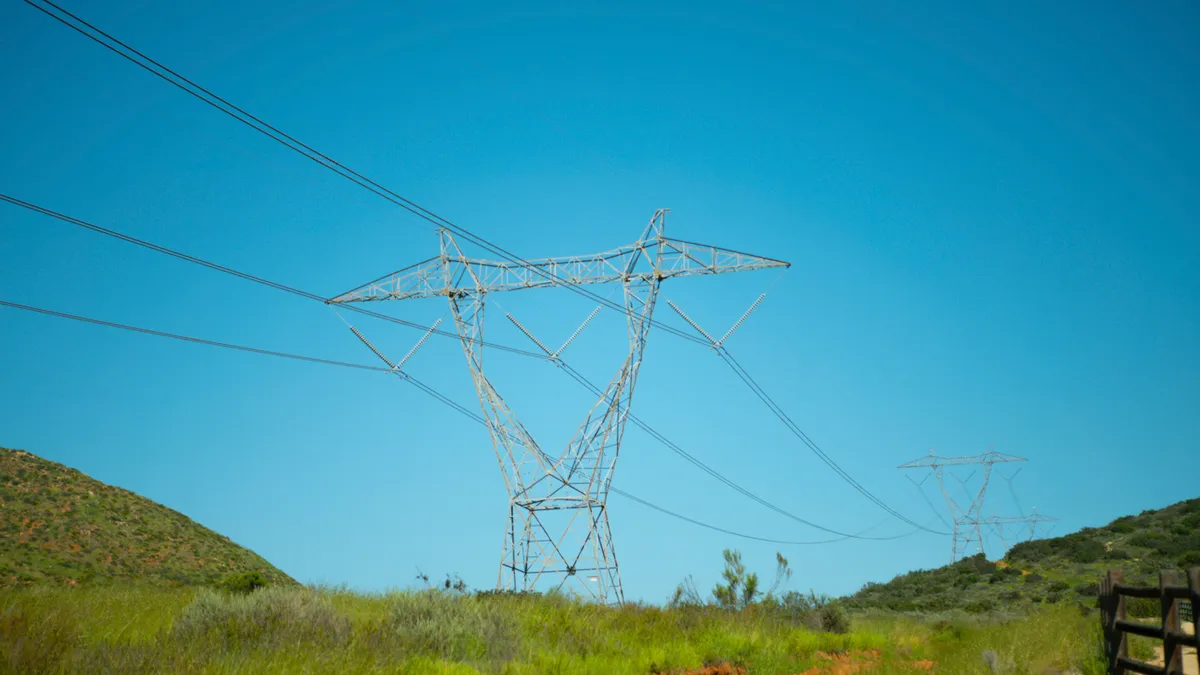The power sector experienced a "Kumbaya" moment last month.
Electric utilities and rooftop solar companies are typically at each other's throats, fighting over net metering policies that provide bill credits to consumers that install their own solar. Utilities claim rooftop solar installations enrolled in net energy metering programs shift grid upkeep costs onto ratepayers without solar. Rooftop solar advocates say utilities do not properly value all the benefits these arrays provide to the grid. The same argument has played out in many U.S. states, from Arizona and Nevada to Hawaii and California.
But in New York, utilities and solar companies have called a truce and are working on a plan that aims to please both sides of the debate.
In April, six utilities and three solar companies shook on a deal to transition away from net metering policy and toward a set of declining incentives and fees for developers. The deal comes as the state moves forward with the Reforming the Energy Vision (REV) initiative, a comprehensive regulatory proceeding that aims to overhaul the traditional utility business model and align utility incentives with the deployment of distributed resources from multiple parties.
The agreement to transition away from retail rate net metering for residential customers is largely unprecedented in the industry. Dubbed the "Solar Progress Partnership," the deal brought together members from both sides of the distribution grid, including Consolidated Edison, SolarCity, SunEdison, Central Hudson Gas & Electric, New York State Electric & Gas, National Grid, Rochester Gas and Electric, Orange and Rockland Utilities, and SunPower Corp.
While both sides of the debate pointed out there is more to be done, they told Utility Dive that open communication and a forward-thinking regulatory framework that encouraged collaboration were key to settling differences in New York.
The question is, could this partnership be replicated in other states?
What happens in New York...
REV extends far beyond solar and looks to holistically overhaul the utility model. In a related docket, regulators are studying how to compensate distributed energy resources, including distributed solar, which opened the door for utilities and solar companies to come together for this collaboration on net metering.
Residential solar has been the focus of high profile net metering debates in other states, but not in New York. The state has two net metering rates: one for residential rooftop solar and one for community-shared distributed generation. While residential net metering has been growing “at a natural pace,” the pressing issue in New York was “community net metering,” said Stephen Wemple, director of the utility of the future team at Consolidated Edison, the power provider for New York City.
Community-shared solar was growing at a faster pace than residential solar, Wemple said. At the time, more than 3,100 MW of renewable energy systems eligible for net metering were in the interconnection queue or that are already hooked up to the grid.
About half of those were community and remote net metering, Wemple said, which he said could raise ratepayer bills and pose problems for the "logistics" of grid interconnection. Something needed to be done, ideally to "establish a boundary for these larger projects."
Last year, an administrative law judge directed solar companies and utilities to come up with a net metering solution satisfactory to both sides at the end of last year.
Eventually, utilities and solar companies proposed a compromise that kept the existing net metering policy until 2020, while adding a fee for solar developers for community solar that depends on their location on the grid.
“What we agreed to a was a framework that brings us away from net metering,” Wemple said. This allows utilities to “build our systems to allow them to really flourish.”
It wasn't easy to get to that point. It took a first-of-its-kind regulatory framework and a push from an administrative law judge to open the door for collaboration, both sides said.
“The government really made it clear to both utilities and industry that the status quo isn’t really a good course of business anymore,” said Jamil Khan, deputy director of policy and electricity markets at SolarCity.
Advanced Energy Economy (AEE), a trade association, worked as mediator for the talks.
“There’s a tremendous need to deal with DERs and rate design issues,” said Lisa Frantzis, senior vice president of strategy at AEE. “I’ve been wanting to pull together a number of our member base to talk about how proactive we can be. It’s a huge opportunity to work with our utilities in a very constructive dialogue.”
Some details still need to be worked out, such as the length of time residential customers will keep retail rate net metering. Negotiators set a vague timeline of 15 to 20 years, while also agreeing to study potential cost-shifting between customer classes and the consequences of net metering on utility revenues.
The proposal would have community solar customers receive full retail net metering credits, but developers would pay a small fee to address the cost-shift. This type of compensation mechanism is novel, as most net metering debates have centered around altering net metering rates and adding fixed fees for customers.
For behind-the-meter solar, customers would continue to be credited at the full retail rate until 2020. Starting in 2020, net metering credits would go down for new solar users until they are equal to the value of distributed solar, as determined under the DER valuation docket.
Both utility and solar representatives agreed this partnership was the first step toward a sustainable collaboration for putting solar on the grid.
“This isn’t a done deal,” Con Ed’s Wemple said. “We still need to work with other stakeholders ... but I think there are other offshoots that are worth continuing.”
Stop, collaborate and listen
The biggest problem facing the utility-solar partnership was finding a middle ground.
“We didn’t want a situation like Nevada,” Frantzis said. “[We’re] working in Arizona and actively involved in New England and having constructive dialogue around rate design issues — is there a successor to net energy metering and if that is needed and when? — and I think we recognize that we wanted to take a more collaborative stance when coming up with solutions.”
For solar companies, a simple compensation scheme, such as net metering, was necessary for their business’ survival.
“Both sides agreed net metering is a successful tool, something that customers understand,” said SolarCity’s Khan. “If we’re going to consider to use it as a customer-facing tool, we’re going to have to incorporate what the commission wanted to do, which is setting a path where their best use is. Based on our experience elsewhere in the country, customers [should] have reasonable certainty [over] what their savings proposition is over the course of their life.”
Utilities wanted regulatory certainty and to address the cost- and revenue-shifts caused by distributed solar under retail net metering. Establishing a framework to discuss the issue helps eliminate “drastically changing outcomes," said Peter Zchokke, director of regulatory strategy for National Grid, told Utility Dive.
“It’s a way of setting the framework,” Zschokke added. “A customer can understand what can possibly happen; at the same time, utilities can see how they can move forward and fund the grid.”
But when asked if this is a partnership could be replicated in other states, both sides took slightly different attitudes. Both Wemple and Zchokke said regulatory schemes differ state by state, so it would hard to see a repeat unless a REV-like regulatory structure existed. Solar companies were slightly more optimistic.
Tom Starrs, vice president of marketing for SunPower, said the maturation of the solar sector played a part in opening up dialogue.
“I think we’re seeing a maturation in the solar industry with respect to its approach to advocacy,” Starrs told Utility Dive. “[We’re] seeing signs that the value of thinking of the utility as a potential partner in crafting a solution that provides headroom for solar industry to thrive.”
“And I think we’re seeing a trend away from what has been trend as labeling utilities as adversaries and using them as a scapegoat for policies that don’t support our policies,” he added.
Lessons learned
The seeds of collaboration between solar companies and utilities are already beginning to appear in other states.
Take Arizona: Home to rancorous debates between solar advocates and utilities, the battle appeared poised to heat up again this year over three dueling ballot initiatives that centered around how to compensate rooftop solar users.
In April, solar advocates rolled out a ballot measure to preserve retail rate net metering. Meanwhile, two lawmakers drafted measures to amend the state constitution to protect regulatory authority when setting rates. But both sides pulled their initiatives and agreed to mediation under the directive of the governor earlier this month.
The agreement to mediation came after utlities and solar companies announced the New York collaboration. While not directly linked to swaying Arizona utilities and solar companies to come to the table, it does appear to promise more collaboration instead of heated accusations during a hearing. New York is just the beginning.
“I hope this [New York collaboration] sends a signal with utilities that we are ready to sit down and discuss this issue with them directly,” SolarCity’s Khan told Utility Dive.
For the utilities, communication is key.
“Communication the first thing to try. You need to communicate in the context of the individual requirements of each state," National Grid's Zschokke said. "[This] shows that communication ... may provide an avenue to a future. What will happen in other states is different. The regulatory framework is different. [New York’s] framework allows us to evolve more to the future and it will evolve to the future.”
Con Ed's Wemple said that defining a long-term vision can bring about cooperation. “Try to define what the long-term vision is and work your way on path towards that," he said. "New York has a long term vision.”
But sometimes, mediation is necessary to get both sides talking to each other, as seen through Frantzis’ work.
“The biggest challenges [are that] even the utilities didn’t agree with each other and some solar companies didn’t all agree,” Frantzis said. “Not everybody is aligned on what the right answer is and ... it’s hard to find common ground.”
Even so, New York’s net metering compromise shows “you can come to the table with different needs and still come out with a win-win solution,” she said.


